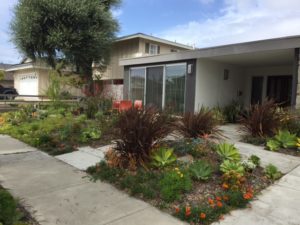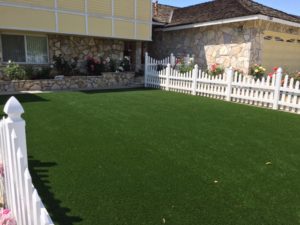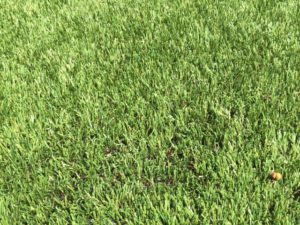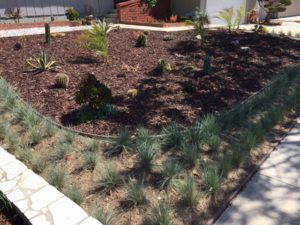May 8 column: Alternative Lawns

I’ve been excited to share with you what I’ve learned about alternative lawns. This includes other types of lawns you can grow and alternatives to having lawns altogether. For this feature story, I interviewed Spokane County Master Gardener Kris Moberg-Hendron for her expertise.
Several years ago, Kris ripped out her lawn and replaced it with drought-tolerant plants. Don’t worry if you’re not quite ready to take the plunge and eliminate your lawn. She has many excellent suggestions on how to reduce the size of your lawn. This can be done while making your landscape very inviting and enjoyable.
Here’s a link to this article: Remove or reduce your lawn for easier gardening. (or you can read my column lower in this post)
Photos of alternative lawns
While we’re on the subject, I wanted to share a few photos with you. The photo at the top of this post shows Kris and her husband Lars sitting in their “lawn-less” front garden. I took the photo a few weeks back, before plants had greened up. That was because I had intended to have this article run quite a bit sooner than today. But I soon realized it would be just as effective to have it run in early May.
The next photos were taken while I was down in Southern California in late March. As you’ve probably heard, California has been experiencing a horrible drought. I wanted to see what homeowners were doing to conserve water yet still have attractive front landscapes.
The first two photos show “fake” lawn, which you have to admit looks pretty decent. The close-up shows how it comes with varying length fibers to make it look a bit more realistic than Astro-turf.
Then I wanted to show you two front landscapes where they’ve planted alternatives to lawns. I was impressed and am hoping the idea will catch on with more folks!

Alternative lawns garden column:
by Susan Mulvihill
Having a lawn is an awful lot of work. They require mowing, watering, fertilizing and keeping on top of those pesky dandelions. Yet we can’t imagine not having a lawn as the foundation for our landscapes. Or can we?
Meet Kris Moberg-Hendron
In 2005, Kris Moberg-Hendron decided to remove her front lawn. Her severe allergies to a substance in turfgrass made the decision easy. She also wanted to follow then-Extension agent Tonie Fitzgerald’s advice to replace lawns with native and drought-tolerant plants.
Moberg-Hendron is a Spokane County Master Gardener who holds a Bachelor’s degree in agriculture. She also had a valid reason for wanting to conserve water. Her husband, Lars Hendron, is the principal wastewater engineer for the city of Spokane.
A staggering water-use statistic:
“The average lawn requires about 34,000 gallons per season to maintain,” she said. “That is a lot of water, especially when you consider how hot and dry our summers are.”
She also knows that running a lawnmower pollutes our environment in more than one way.
“I have a problem with the noise pollution caused by lawnmowers,” she admitted. “I’d rather hear children playing and laughing, cyclists going by, and be able to talk with my neighbors. You can’t do that over the sound of lawnmowers.”
In addition to her allergies and the amount of water lawns require, she can think of another valid reason to remove one’s lawn: less maintenance.
“We’re all busy so we don’t have time to maintain a yard,” she said. The fewer things we have to do on a weekly basis, the better. And if you replace your lawn with native and drought-tolerant plants, you have minimal maintenance.”
Kris Moberg-Hendron’s solution and advice
Moberg-Hendron has two main recommendations: completely replace your lawn or reduce the size of it. Let’s look at each of these options.
In her case, she removed her front lawn “shovelful by shovelful.” It took her two weeks. Then she terraced the area due to its steep slope. She then added a layer of compost to add nutrients since much of the topsoil was lost.
Oregon grape, kinnikinnick, prickly-pear cactus, mountain ash and Ponderosa pines are some of the natives she planted. For drought-tolerant plants, she chose Russian sage, lavender, ornamental grasses, irises, cotoneaster, sedum and salvi., Other plants included burning bush, hens-and-chicks, penstemon and hardy geraniums. A few bulbs, peonies and bleeding hearts were added for extra color.
Drip irrigation is a great way to conserve water
Moberg-Hendron uses drip irrigation to water everything. She assigned the plantings to different zones based on the amount of water they require. She also deep-waters her shrubs and trees from late September until the first hard freeze. That means they’ll be well-hydrated going into the winter.
Are you interested in going with an alternative lawn that doesn’t need much water? She recommends Dutch white clover, eco lawns (a mixture of drought-tolerant grasses and clovers) or fine fescues. Fescues have a clumping habit. Because of this, they’re best used on lawns with minimal foot traffic or where children won’t be playing.
She’s a big fan of Dutch white clover. That’s because it fixes nitrogen in the soil so it will feed the lawn. It also keeps a lawn looking green in the heat of the summer, when traditional grasses die back.
Moberg-Hendrons suggestions for reducing the size of your lawn
“We need to make room in our landscapes for people,” she related. “One way to do this is to add hardscapes — pathways, decks and patios — which invite you out into the landscape.”
Hardscapes located next to a house should be sloped slightly so water drains away from the structure. Typical materials include stone, gravel, bricks, concrete pavers, wood and synthetic decking. Another option is to use urbanite, which is a term for recycled building materials such as broken concrete.
She encourages enlarging patios so they are more comfortable for entertaining, but designing them to require minimal maintenance.
When constructing pathways, they should be 3 to 4 feet wide, to accommodate two people walking together. But Moberg-Hendron likes to go one step further:
“You want a visual treat when you get to the end of the path,” she suggested. “That’s the whole reason we enjoy gardens, right?”
These treats include water features or a single specimen of a spectacular plant. Or perhaps a stunning container, or a bench where you can sit and relax.
Moberg-Hendron’s alternative front yard is catching on in her neighborhood.
“We’ve helped one neighbor take out part of her lawn and put in a flagstone path,” she said. “Others have expanded their garden beds and some have added clover to their lawns. I love seeing this happen.”
Resources
The Spokane County Master Gardeners have information on grasses for this region. Other resources are on lawn substitutes, native and drought-tolerant plants, and drip irrigation. Contact them at (509) 477-2181 or email mastergardener@spokanecounty.org.



